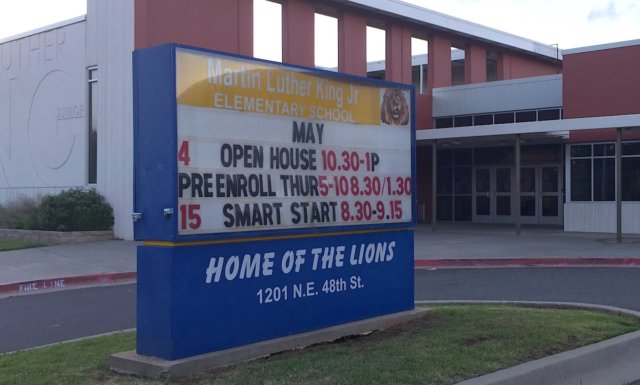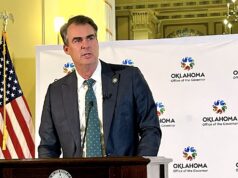

Given the excellence of Classen SAS, Southeast H.S., and Belle Isle Enterprise School, expanding access to these magnet schools makes sense for OKCPS in its new Pathway to Greatness realignment.
But what will be the education values that drive the district’s effort to turn around high-challenge schools using the transformation school model? And if the district invests in Britton, Martin Luther King, Thelma Parks and Rockwood elementaries to become “innovative transformation schools,” will the instruction be similar to that of previous transformation schools?
“Our goal is to help prepare middle-schoolers to be able to be successful,” Southeast Middle School’s new principal, Rhonda Schroeder, explained to The Oklahoman’s Tim Willert. “Our academics will be enriched with science and technology and engineering.”
Similarly, Belle Isle’s students take Spanish, math exploration classes that connect concepts with real-world applications and elective topics like gardening and STEM projects.
“The school produces exceptionally well-rounded students thanks to great teachers, great leaders and so many opportunities for students to become engaged through academics, fine arts, athletics and other extracurricular activities,” said Christy Watson, a Belle Isle parent. “Belle Isle’s culture is incredibly supportive and revolves around individual student success while still fostering the development of personal responsibility.”
Transformation school experiment used teacher accountability, incentives
OKCPS’s previous and different transformation school experiment was the most commonly used reform method funded by the Obama administration’s $3.5 billion School Improvement Grants. These grants sought to use teacher accountability and incentives to drive dramatic improvements of test scores and other metrics in only three years. The OKCPS transformation plans called for bonuses up to $6,000 for meeting test score goals. It thus incentivized a narrowly focused instruction mindset which was the opposite of the holistic learning in Oklahoma City’s application schools.
RELATED
During OKCPS transition, community should be patient by John Thompson
The most comprehensive evaluation of the now-abandoned SIG program across the nation found “no significant impacts on math or reading test scores, high school graduation, or college enrollment.” In one OKCPS transformation school, Douglass, the model contributed to the resignation of its long-admired principal for manipulating accountability metrics. Only one SIG school in Oklahoma City, U.S. Grant High School, showed meaningful gains. However, Grant used a different model and contributed to huge increases in suspensions that led the U.S. Office of Civil Rights to intervene in the district’s discipline procedures.
It is too soon to judge whether the OKCPS’s new, much smaller transformation plans will learn from previous failures, but information on the district’s website is not encouraging. Ignoring social science research to the contrary, it says “Leadership and Instructional Coaching” will “support dramatic improvements for all students.” Despite research suggesting it would likely take incentives in the area of $10,000 per year to attract the higher quality teachers required by turnarounds, the district seems to believe in financial incentives and professional development to meet “high-impact goals.” It also says OKCPS is “learning from other similar districts that have been investing in school turnaround (Baltimore, Boston, Houston, Atlanta).”
Only one of the districts being studied, Boston, has a history of success in transforming high-poverty schools, and after the SIG money disappeared, the gains for low-income students also vanished. After showing little or no benefits due to generously funded SIG transformations, the other three districts have since seen a decline in student performance for economically disadvantaged students on the reliable NAEP tests.
I asked OKCPS spokesperson Arely Martin how new transformation schools would be different from the failed SIG transformation schools. Martin said the district is embracing “innovative” transformation, not SIG transformation schools. The new effort will wisely focus on elementary schools, seek “home-grown” approaches and utilize seasoned leadership, she said. And it will invest in culturally responsive practices and socio-emotional supports. Martin described it as “a marathon not a sprint.”
Promises easy, building capacity difficult
Like the SIG transformations, the innovative transformations appear to rely heavily on effective school and teacher leaders, as well as teacher incentives. It is easy to make such promises, but building capacity for real improvement is likely to be even more difficult today. For instance, back then, the district received millions of dollars of stimulus money which funded a curriculum and professional development program, America’s Choice, which I suspect was far more likely to lead to meaningful, holistic instruction.
Martin said OKCPS had spent $3 million, each, for a few SIG transformation schools. In fact, it invested over $28 million on six schools, not counting another $5 million for the U.S. Grant High School turnaround, and the stimulus-funded America’s Choice instructional supports. Outputs for transformation schools either remained flat or declined.
I was often at the table a decade ago when administrators and teachers sought to work collaboratively within the SIG regulations. We hoped the transformation approach would not undermine the OKCPS’s then-new holistic, evidence-based policies for peer evaluation of teachers and using a continuous calendar to offer enrichment, not remediation. Before long, however, the district was completely focused on students’ weakness, as opposed to building on their strengths.
Federal regulations undermined promising, evidence-based OKCPS programs. They incentivized teach-to-the-test instruction and a narrowing of the curriculum in ways that are antithetical to the meaningful learning which is offered in magnet schools. But, the district complied more than was necessary. The federal regulations would have allowed investments in socio-emotional supports, and they didn’t prohibit the district from trying to provide holistic teaching and learning.
The lessons I drew are that mixed messages, impossible-to-meet targets and rushed shortcuts are counter-productive. The district will have its work cut out for it building the student supports necessary for its innovations to succeed starting in the fall. I hope the OKCPS will take a deeper look at what went wrong with transformations and move toward a plan that is different than a dramatically underfunded SIG-lite.





















